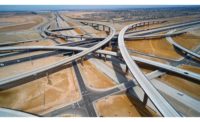Two of the flyover bridges were not scheduled to be built until the Loop 303 southbound interchange from I-10 was completed in a separate phase scheduled to bid in 2016. But once Pulice Construction began work, the Arizona Dept. of Transportation added the two bridges to the current schedule in order to limit future impacts on I-10.
"Our staff continued to look at the interchange project and plans for the follow-on project that will construct the south half of the interchange starting in 2016," says Doug Nintzel, spokesman for ADOT. "The decision was made to add sections, or frames, of two future elevated ramps over I-10 now rather than later.
"The $10.9-million change order is a wise investment," he adds. "When it comes time to build the south half of the interchange, crews will not have to build directly over I-10 because those ramp sections will already be in place. So we're enhancing safety while being more efficient and reducing inconveniences for I-10 drivers during that next project."
While most of the Loop 303/I-10 interchange activity involves new construction, nearly a mile of I-10 will be rebuilt and realigned by the end of the project. East- and west-bound I-10 traffic will be moved to the newly constructed west-bound lanes of I-10 in late July. Work will then pick up on the south side of the project site to demolish the remaining portion of I-10, complete the overlapping bridges and construct the future east-bound I-10 lanes.
"Now it's a race to demo, tear out the old and build in the new," Miranda says. "Our challenge now is to complete the flyover. We are going to be working on the true stack area."
CANAL CHALLENGEs
Crews must also contend with a canal owned by the Roosevelt Irrigation District (RID) that runs across I-10 at the eastern edge of the project and then continues nearly parallel on the south side of I-10. The work on the canal was something rarely seen in a tiered intersection project, according to Andrew Baird, project engineer for Aztec Engineering of Phoenix.
"As part of this project, approximately 2,600 feet of the open RID canal will now be enclosed within a reinforced concrete box culvert (RCBC) within the current canal alignment," Baird says. The canal was redirected and has already been placed within a boxed culvert, where it runs under I-10. It will also be enclosed in another boxed culvert where it crosses Loop 303. "In order to relocate the existing RID canal at these two locations, two temporary canal bypasses were required," he adds.
Design and construction of the bypass wyes and the new boxed culverts were coordinated with regular November dry-up periods usually reserved for cleanup and maintenance. The proximity of the canal to the heavily trafficked I-10 and the presence of other utilities added to the complexity of the design and construction of the bypass wyes and the new RCBC.
"The I-10 crossing, which is now complete, was the more complicated of the two," says Curt Slagell, senior vice president of Aztec Engineering. The bypass was placed on the northwest side of the existing canal, under the existing I-10 bridge. "Excavation adjacent to existing piers had to be considered as traffic was to be maintained on I-10 during construction," Slagell says.




